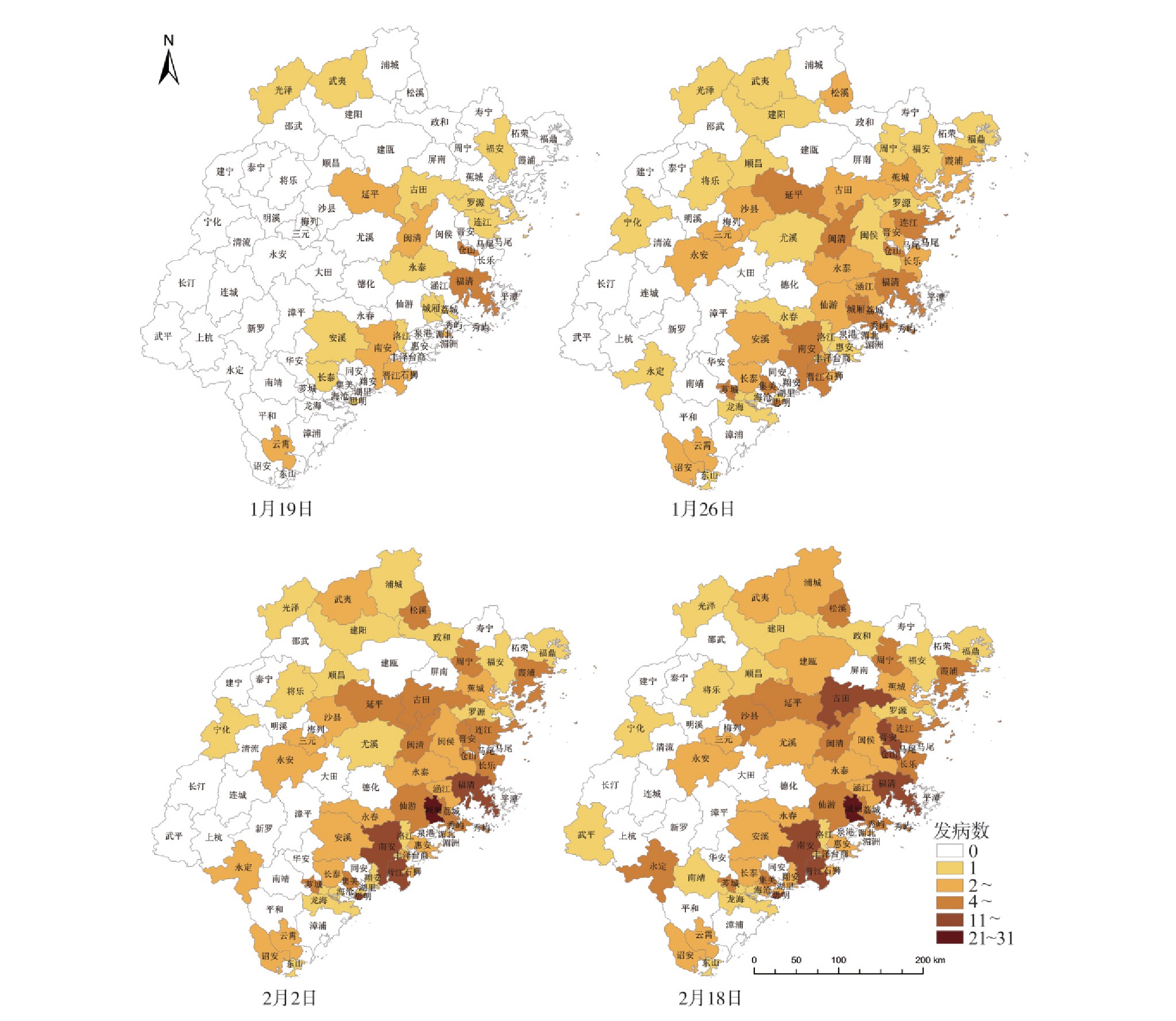-
摘要:
目的 分析福建省新型冠状病毒肺炎(COVID-19)疫情趋势和预测时空聚集性, 为风险评估和防控提供参考。 方法 对福建省2020年1月2日―2020年2月18日COVID-19发病数进行时空趋势分析和预测。 结果 福建省2020年1月2日―2020年2月18日COVID-19报告发病数为293例, 无死亡。各时间点累计报告县(区)数(累计报告数)依次为:1月19日22个(35例)、1月26日53个(159例)、2月2日57个(244例)、2月18日61个(293例)。局部空间自相关分析提示, 截至2月18日, 鼓楼、仓山、闽侯、福清等福州县(区)热点性质为高聚集区。截至1月26日, 时空聚集区快速蔓延, 一级和二级聚集区多达7个, 分别以鲤城、涵江、思明、连江、沙县、古田和湄北为中心, 其中以鲤城和思明为中心预测发生于1月27日―2月18日, 期望发病数分别为54和24例。截至2月18日, 时空聚集区减少至2个, 分别以城厢和南安为中心。 结论 泉州、福州、莆田等市的部分县(区)COVID-19时空聚集风险较大, 应重点防控, 但低风险聚集区也不应忽视。 Abstract:Objective To study the trend of COVID-19 epidemics in Fujian and predict the spatiotemporal clustering in order to provide a reference for risk assessment and prevention and control. Method The incidence of COVID-19 in Fujian Province from Jan 2, 2020 to Feb 18, 2020 was used to analyze and predict the spatiotemporal trend. Results The number of cases reported by COVID-19 from Jan 2, 2020 to Feb 18, 2020 in Fujian Province was 293, with no deaths. The cumulative number of counties(districts) reported at each time point(accumulated reports) were: 22 on Jan 19(35 cases), 53 on Jan 26(159 cases), 57 on Feb 2(244 cases), and 61 on Feb 18(293 cases). Local spatial autocorrelation analysis suggested that as of Feb 18, the hot spots in Fuzhou counties(districts) such as Gulou, Cangshan, Minhou, and Fuqing were highly clustered. As of January 26, the space-time gathering area had spread rapidly, with up to 7 first and second level gathering areas, centered on Licheng, Hanjiang, Siming, Lianjiang, Shaxian, Gutian, and Meibei, of which carp Licheng and Siming were predicted to occur from January 27 to February 18, with 54 and 24 cases expected. As of February 18, the space-time gathering area had been reduced to two, centered on Chengxiang and Nanan respectively. Conclusion Some counties(districts) in Quanzhou, Fuzhou, Putian and other regions have a high risk of spatiotemporal aggregation, and they should be focused on prevention and control, but low-risk aggregation areas should not be ignored. -
Key words:
- COVID-19 /
- Spatial autocorrelation /
- Spatial-temporal scanning /
- Trend analysis /
- Prediction
-
表 1 2020年福建省COVID-19全局空间自相关分析
Table 1. Global spatial autocorrelation analysis of COVID-19 in Fujian, in 2020
截至时间 Moran's I 预期指数 S2 Z值 P值 1月19日 -0.059 7 -0.047 6 0.000 3 -0.670 5 0.503 1月26日 0.003 7 -0.019 2 0.000 1 2.488 5 0.013 2月2日 0.000 7 -0.017 9 0.000 1 2.239 3 0.025 2月18日 0.002 7 -0.016 7 0.000 1 2.401 2 0.016 表 2 2020年福建省COVID-19局部空间自相关分析
Table 2. Local spatial autocorrelation analysis of COVID-19 in Fujian, in 2020
截至时间 热点一(高聚集区)Gi* > 2.58 热点二(中聚集区)1.96 < Gi* < 2.58 热点三(低聚集区)1.65 < Gi* < 1.96 1月19日 无 城厢、荔城 湄北 1月26日 仙游、石狮、湄北 仓山、闽侯、福清、长乐、城厢、鲤城、丰泽 晋江、南安、惠安、涵江、荔城、 2月2日 湄北 鼓楼、仓山、闽侯、福清、长乐、仙游、城厢、鲤城、丰泽、石狮 永泰、晋江、南安、惠安、涵江、荔城、 2月18日 鼓楼、仓山、闽侯、福清 永泰、涵江、仙游、湄北、鲤城、丰泽、石狮 南安、惠安、秀屿 表 3 2020年福建省COVID-19发病时空扫描
Table 3. patial-temporal scan of the incidence of COVID-19 in Fujian, in 2020
截至时间 聚集分类 聚集时间 县(区)数(个) 聚集中心 半径(km) 发病数(例) 期望发病数 RR值 LLR值 P值 1月19日 高 1月16日―1月19日 5 永泰 48.80 12 1.27 13.81 18.11 < 0.001 中 1月20日―2月12日 2 思明 38.24 0 7.56 0.00 8.51 0.023 1月26日 高 1月27日―2月18日 8 鲤城 43.63 0 54.39 0.00 66.56 < 0.001 高 1月18日―1月26日 7 涵江 48.98 38 7.81 6.08 33.19 < 0.001 高 1月27日―2月18日 3 思明 14.53 0 24.25 0.00 26.31 < 0.001 高 1月14日―1月26日 6 连江 41.03 18 3.74 5.30 14.70 < 0.001 高 1月18日―1月25日 5 沙县 48.82 11 1.22 9.58 14.68 < 0.001 高 1月16日―1月26日 2 古田 41.28 9 0.91 10.48 12.79 0.002 中 1月16日―1月25日 2 湄北 19.18 5 0.27 18.82 9.87 0.034 2月2日 高 1月21日―2月2日 1 城厢 0.00 26 4.58 6.23 23.39 < 0.001 高 1月2日―2月18日 6 翔安 40.49 53 103.75 0.38 22.52 < 0.001 高 2月3日―2月18日 1 晋安 0.00 0 17.66 0.00 18.33 < 0.001 中 1月25日―2月1日 1 周宁 0.00 6 0.47 13.08 9.82 0.034 2月18日 高 1月2日―2月18日 5 南安 25.95 39 90.35 0.34 24.60 < 0.001 高 1月21日―2月2日 1 城厢 0.00 26 5.71 4.90 19.86 < 0.001 -
[1] 中国疾病预防控制中心新型冠状病毒肺炎应急响应机制流行病学组.新型冠状病毒肺炎流行病学特征分析[J].中华流行病学杂志, 2020, 41(2): 145-151.DOI: 10.3760/cma.j.issn.0254-6450.2020.02.003.Epidemiology Working Group for NCIP Epidemic Response. The epidemiological characteristics of an outbreak of 2019 novel coronavirus diseases(COVID-19)in China[J]. Chin J Epidemiol, 2020, 41(2): 145-151. DOI: 10.3760/cma.j.issn.0254-6450.2020.02.003. [2] Wang C, Hornby PW, Hayden FG, et al. A novel coronavirus outbreak of global health concern[J]. Lancet, 2020, 395(10223): 470-473.DOI: 10.1016/S0140-6736(20)30185-9. [3] Paules CI, Marston HD, Fauci AS. Coronavirus infection-more than just the common cold[J]. JAMA, 2020, 323(8): 707-708.DOI: 10.1001/jama.2020.0757. [4] Munster VJ, Koopmans M, van Doremalen N, et al. A novel coronavirus emerging in China-key questions for impact assessment[J]. N Engl J Med, 2020, 382(8): 692-694.DOI: 10.1056/NEJMp2000929. [5] Huang C, Wang Y, Li X, et al. Clinical features of patients infected with 2019 novel coronavirus in Wuhan, China[J]. Lancet, 2020, 395(10223): 497-506.DOI: 10.1016/S0140-6736(20)30183-5. [6] Chan JF, Yuan S, Kok KH, et al. A familial cluster of pneumonia associated with the 2019 novel coronavirus indicating person-to-person transmission: a study of a family cluster[J]. Lancet, 2020, 395(10223): 514-523.DOI: 10.1016/S0140-6736(20)30154-9. [7] 饶华祥, 蔡芝锋, 徐莉立, 等.青海省2014-2016年肺结核空间分布特征及可视化分析[J].中华流行病学杂志, 2018, 39(3): 347-351.DOI: 10.3760/cma.j.issn.0254-6450.2018.03.019.Rao HX, Cai ZF, Xu LL, et al. Spatial distribution characteristics of tuberculosis and its visualization in Qinghai Province, 2014-2016[J]. Chin J Epidemiol, 2018, 39(3): 347-351. DOI: 10.3760/cma.j.issn.0254-6450.2018.03.019. [8] Zulu LC, Kalipeni E, Johannes E. Analyzing spatial clustering and the spatiotemporal nature and trends of HIV/AIDS prevalence using GIS: the case of Malawi, 1994-2010[J]. BMC Infect Dis, 2014, 14: 285.DOI: 10.1186/1471-2334-14-285. [9] Lopez D, Gunasekaran M, Murugan BS, et al. Spatial big data analytics of influenza epidemic in vellore, India[J]. Proc IEEE Int Conf Big Data, 2014: 19-24.DOI: 10.1109/BigData.2014.7004422. [10] 祝寒松, 王灵岚, 林代华, 等.福建省2011-2016年人间布鲁氏菌病流行病学分析和时空聚集探测[J].中华流行病学杂志, 2017, 38(9): 1212-1217.DOI: 10.3760/cma.j.issn.0254-6450.2017.09.014.Zhu HS, Wang LL, Lin DH, et al. Analysis on epidemiology and spatial-temporal clustering of human brucellosis in Fujian Province, 2011-2016[J]. Chin J Epidemiol, 2017, 38(9): 1212-1217. DOI: 10.3760/cma.j.issn.0254-6450.2017.09.014. -





 下载:
下载:



